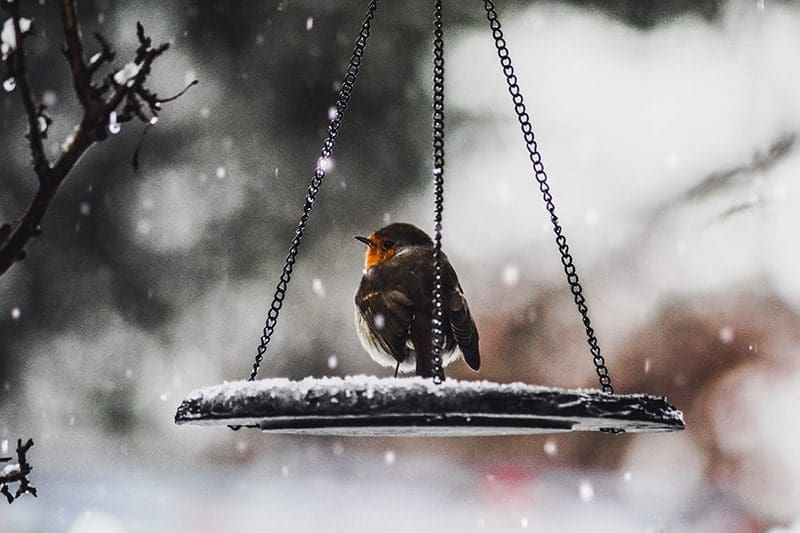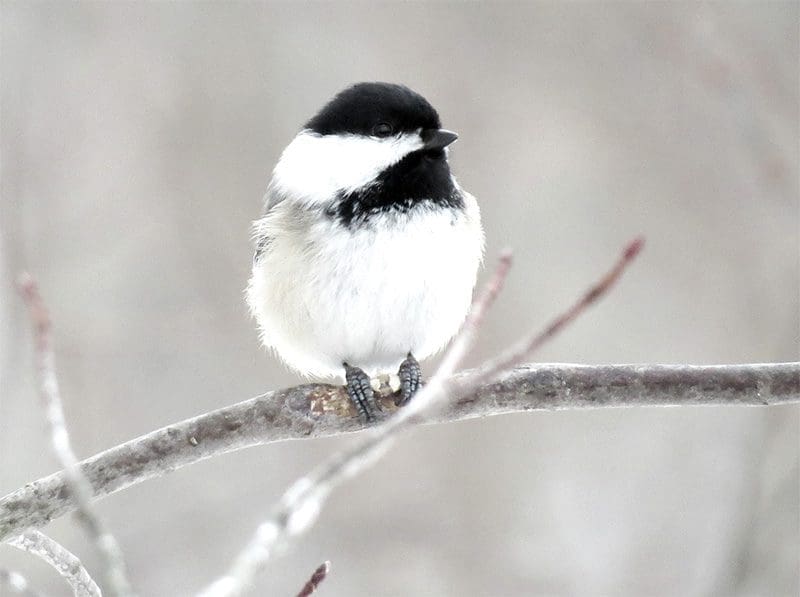
When you look outside on a cold winter day and see a feathered friend clinging to a frozen branch, you start wondering how to help birds in winter.
Once you see how much the birds appreciate your help, you will be hooked! It is very rewarding to help your local birds get through the cold winter so you can all celebrate spring together.
In this article, the whimsyBirdy team will explain the top 3 ways to help birds in winter. We’ll also let you know about some common mistakes you should avoid.
Let’s fly into it!
Table of Contents
- Can We Actually Help Birds in Winter?
- Top 3 Ways to Help Birds in Winter
- Common Mistakes to Avoid
- Cozy Winters and Happy Birds
Can We Actually Help Birds in Winter?

There is some debate among experts about whether or not we can actually help birds in winter. The main sticking point is whether we can make a positive impact on the total bird population or not.
Putting out food in the winter time gives your local birds access to a lot more energy which definitely helps them. And as far helping the total bird population, we at whimsyBirdy think that we just need a lot more people to help out their local birds!
If enough people start helping local birds in the winter, that will begin to really add up and eventually we will make a positive impact on the total bird population. And that will definitely settle the debate.
So, let’s move on to the top 3 ways to help birds in the winter!
Top 3 Ways to Help Birds in Winter

If you do the following 3 things, you will make your local birds very happy in the winter time.
1.) Put out Lots of Bird Feed in Safely Placed Bird Feeders
When birds gather at a bird feeder, they can be a target for predators such as hawks or nature’s purrfect predator, the curious house cat!
So, it’s important to place your feeders within 12 feet of a safe place such as a tree, bush, or brush pile. A bird can quickly dart away to safety if there is danger and then return to the feeder once the danger has passed.
For winter feeding, it’s great to offer a mix of bird feed such as black oil sunflower seed, white proso millet, suet cakes, peanuts, cracked corn, and nyjer seed.
If you’re just starting out, black oil sunflower seed and suet cakes is a great base and then you can add the others over time.
Looking for a New Bird Feeder?
If you’re in the market for a new bird feeder, please check out the collection of Bird Feeder Articles by whimsyBirdy!
We have product reviews and tips on a variety of bird feeders for every birdy situation.
2.) Scatter Bird Feed in Sheltered Areas
Some birds are ground feeders and you can really help them out by spreading bird feed at the base of bushes, the edge of the woods, the base of a small tree, or even underneath your deck.
We like spreading black oil sunflower seed, peanuts, and cracked corn in these sheltered areas. The birds absolutely love it! They get access to lots of high energy food with protection from predators.
3.) Plan for the Weather and Be Consistent
Keep an eye on your bird food stock pile and make sure to restock regularly. The birds will eat a lot of food when bad weather hits so that’s not a great time to run out. There will be sad bird eyes outside looking in at you and no one wants that.
The birds will look forward to the feed you put out so it’s good to be consistent and put fresh feed out every day. Earlier in the day is best as breakfast is the most important meal of the day for birds.
There may also be a break in the weather which would be a good time to clean out your feeders. You can soak them in a mixture of one part bleach to nine parts hot water to disinfect them.
Next, let’s discuss some common mistakes to avoid when trying to help birds in winter.
Common Mistakes to Avoid
Here are a few common mistakes to avoid when you are trying to help birds in the winter time.
1.) Don’t Put Out Leftovers
The most common one we see here is bread, which is a tricky one. The birds seem to love it, but it doesn’t provide any real nutritional value to them. So, they’re filling up on a low energy food that won’t help them very much.
Most of the foods that we eat aren’t good for birds so it is best to avoid putting out any kind of left overs or table scraps for them.
2.) Watch the Windows
You can place a bird feeder very close to a window or a good distance away. The danger zone is about 5 feet to 25 feet away from the window as the birds may become confused by the window reflection.
If you notice that birds are hitting your window, you can try moving the feeder and see if that helps. You can also try attaching some reflective materials like streamers to keep the birds from becoming confused by the glass.
Cozy Winters and Happy Birds
We hope this article has fired you up to start helping birds in winter. At whimsyBirdy, we feel that our bird friends can use all the help they can get. It’s not easy being a little bird in a big snowy world!
We wish both you and your local birds many cozy winters and song filled springs.
Join the whimsyBirdy Flock!
If you enjoyed this whimsyBirdy Blog article, please join our flock by signing up for the whimsyBirdy mailing list.
We’ll let you know when new articles are published and we’ll bring you along with us as we grow and work on our mission to advocate for birds everywhere.
Thank you for supporting whimsyBirdy!
whimsyBirdy Mission
Our mission is to share our love of birds and nature with you and add a little dash of whimsy along the way.
We share bird watching videos and nature videos from our home and surrounding areas on Youtube and we publish bird and nature articles on the whimsyBirdy Blog.
Please subscribe to our Youtube Channel and let’s share the love of birds and nature with the world!
Birds are truly one of our greatest treasures here on earth, and we want them to thrive for generations to come. We also want to encourage everyone to develop a deep appreciation for nature and all the amazing animals (including humans!) that live there.
If you would be interested in making a monthly support pledge to help us with our mission, please visit our Patreon Membership Page.
Sources and Additional Reading
The Humane Society of the United States
Cardinal Photo by Patrice Bouchard
Robin Photo by Clever Visuals
Chickadee Photo by Christina Brinza
